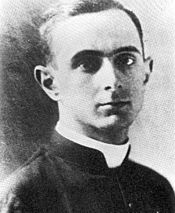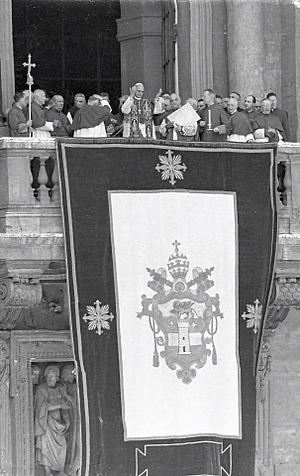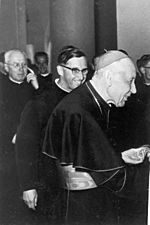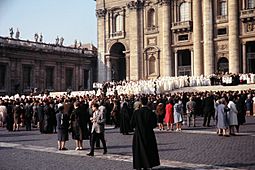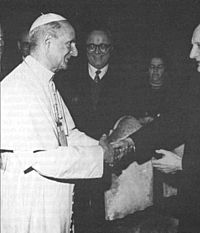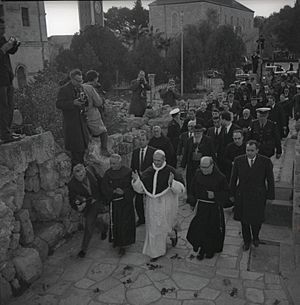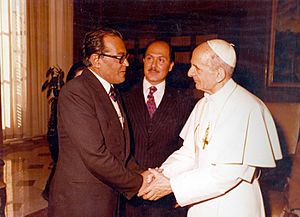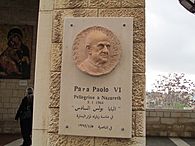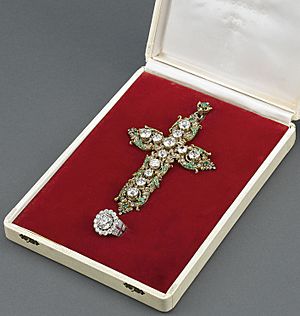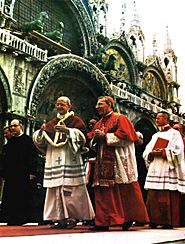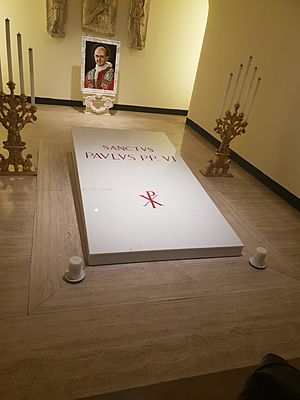Pope Paul VI facts for kids
Quick facts for kids Pope Saint Paul VI |
|
|---|---|
| Bishop of Rome | |
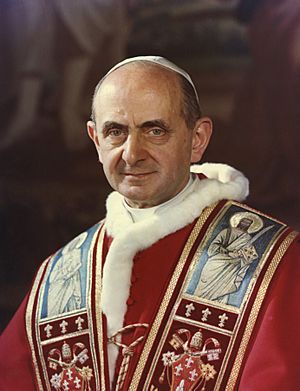
Official photograph, 1969
|
|
| Church | Catholic Church |
| Papacy began | 21 June 1963 |
| Papacy ended | 6 August 1978 |
| Predecessor | John XXIII |
| Successor | John Paul I |
| Orders | |
| Ordination | 29 May 1920 |
| Consecration | 12 December 1954 by Eugène Tisserant |
| Created Cardinal | 15 December 1958 |
| Personal details | |
| Birth name | Giovanni Battista Enrico Antonio Maria Montini |
| Born | 26 September 1897 Concesio, Brescia, Lombardy, Kingdom of Italy |
| Died | 6 August 1978 (aged 80) Castel Gandolfo, Italy |
| Previous post |
|
| Education | University of Milan (JCD) |
| Motto |
|
| Signature | |
| Coat of arms |  |
| Sainthood | |
| Feast day |
|
| Venerated in |
|
| Beatified | 19 October 2014 Saint Peter's Square, Vatican City by Pope Francis |
| Canonized | 14 October 2018 Saint Peter's Square, Vatican City by Pope Francis |
| Attributes |
|
| Patronage |
|
| Shrines | none |
| Other Popes named Paul | |
Pope Paul VI (born Giovanni Battista Enrico Antonio Maria Montini, 26 September 1897 – 6 August 1978) was the leader of the Catholic Church and the Vatican City State from 1963 until his death in 1978. He became Pope after John XXIII and continued the important Second Vatican Council. This council brought many changes to the Church.
Pope Paul VI worked to improve relationships with other Christian churches, like the Eastern Orthodox and Protestant churches. He made history in 1964 by being the first Pope to travel by airplane and the first to visit the Holy Land in over a century.
Before becoming Pope, Montini worked for the Holy See's Secretariat of State from 1922 to 1954. He was a close advisor to Pope Pius XII. In 1954, he became the Archbishop of Milan, a very large Italian diocese. Pope John XXIII made him a Cardinal in 1958. When John XXIII died, Montini was chosen as the next Pope and took the name Paul VI.
He continued the Second Vatican Council, which had paused after John XXIII's death. After the council, Paul VI helped put its new rules and ideas into practice. He made many big changes to Church life. He also spoke often about the Virgin Mary and named her the "Mother of the Church". Pope Paul VI saw himself as a helper for all people, especially those who were suffering. He asked richer countries to help poorer ones.
Later, Pope Benedict XVI declared that Paul VI lived a life of great goodness, calling him "Venerable" in 2012. Pope Francis declared him "Blessed" in 2014 after a miracle was recognized. Paul VI was made a Saint by Pope Francis on 14 October 2018. His special day is celebrated on 29 May.
Contents
- Early Life and Becoming a Priest
- Working in the Vatican
- Archbishop of Milan
- His Time as Pope
- Becoming Pope
- Changes to Papal Traditions
- Finishing the Vatican Council
- Church Reforms
- Relationships and Discussions
- Attempted Attack
- New Diplomacy
- Key Teachings (Encyclicals)
- Spreading the Faith (Evangelism)
- Working with Other Churches (Ecumenism)
- Beatifications and Canonisations
- Appointing Cardinals
- Final Years and Death
- Becoming a Saint
- See also
Early Life and Becoming a Priest
Giovanni Battista Enrico Antonio Maria Montini was born in Concesio, Italy, in 1897. His father, Giorgio Montini, was a lawyer and journalist who was also a member of the Italian Parliament. His mother, Giudetta Alghisi, came from a noble family. He had two brothers.
Giovanni was baptized on 30 September 1897. He went to a Jesuit school and finished high school in 1916. He often had to stop his studies because of illness.
In 1916, he began studying to become a Catholic priest. He was ordained a priest on 29 May 1920 in Brescia. He then studied canon law in Milan. Later, he continued his studies in Rome. In 1922, at age 25, he started working in the Vatican's Secretariat of State. This meant he never worked as a parish priest. In 1925, he helped start a publishing company called Morcelliana. It aimed to promote Christian culture.
Working in the Vatican
Early Diplomatic Work
Montini had only one foreign assignment as a diplomat for the Vatican. He worked as a Secretary in Poland in 1923. He learned about nationalism there, which he described as treating foreigners as enemies. He found this experience "useful, though not always joyful". Later, when he became Pope, Poland's government did not allow him to visit.
Serving the Pope
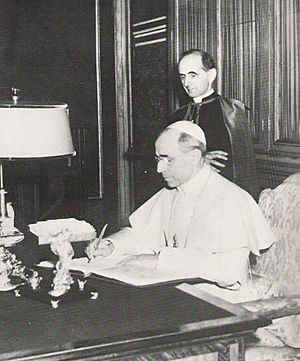
Montini was very good at organizing things, which led him to a career in the Roman Curia, the Vatican's main administration. He was appointed to various important roles. In 1937, he became a Substitute for Ordinary Affairs under Cardinal Pacelli.
When Pacelli became Pope Pius XII in 1939, Montini continued in his role. He met with the Pope every morning until 1954 and became very close to him. During World War II, Montini was a key figure in the Vatican's Secretariat of State. He helped manage thousands of letters from people around the world asking for help.
Montini set up an office to help prisoners of war and refugees. From 1939 to 1947, this office received nearly ten million requests for information about missing people. It sent out over eleven million replies. Montini was sometimes criticized by the Italian government for getting involved in politics, but the Vatican always defended him.
After the war, Montini helped create the Pontifical Commission for Assistance. This group provided shelter, food, and other help to many Romans and refugees. The Pope's summer home, Castel Gandolfo, and parts of Vatican City were opened to refugees. About 15,000 people lived in Castel Gandolfo alone, supported by this commission. Montini also helped bring back Church Asylum, which protected hundreds of Allied soldiers, Jews, and others. In 1971, he changed the Pontifical Commission for Assistance into Caritas Italiana, a well-known charity.
Archbishop of Milan
In 1954, Montini was chosen to be the Archbishop of Milan, a very important role. Pope Pius XII called him his "personal gift to Milan". Cardinal Eugène Tisserant consecrated him as a bishop in Saint Peter's Basilica. Pius XII, who was ill, spoke about Montini's appointment over the radio.
Montini enjoyed his new job in Milan, connecting with all kinds of people. He liked meeting with thinkers, artists, and writers.
Montini's Ideas
In his first months, Montini showed interest in working conditions. He spoke with unions and gave speeches about labor issues. He believed churches were important places for spiritual rest in modern society. So, he started building over 100 new churches.
His speeches were noticed everywhere. Some saw him as a modern thinker. He welcomed a group of Anglican clergy to Milan in 1957. He also exchanged letters with the Archbishop of Canterbury.
Pius XII had offered Montini the chance to become a cardinal in 1952, but Montini declined. Pius XII did not create any new cardinals after Montini went to Milan. However, when Angelo Roncalli became Pope, he made Montini a cardinal in December 1958.
Montini and John XXIII were friends. But when John XXIII announced a new Ecumenical Council, Montini was surprised. He was appointed to a special commission for the council. He did not speak much during the council debates. His main advisor was Giovanni Colombo, who later became his successor in Milan.
Reaching Out to People
In Milan, Montini was seen as a progressive leader. He changed how pastoral care was done, using new ways to reach people. He made sure the Church's new rules for worship were followed. For example, in 1957, he organized for over 500 priests and many bishops to give 7,000 sermons. These sermons were given not just in churches, but in factories, homes, schools, and other places. His goal was to bring faith back to the city.
In 1957, Pope Pius XII asked Archbishop Montini to give a presentation in Rome. Montini spoke about the role of lay people (non-clergy) in the Church. He said: "Apostolate means love. We will love all, but especially those, who need help... We will love our time, our technology, our art, our sports, our world."
Becoming a Cardinal
In 1958, Pope John XXIII made Montini a cardinal. This meant he had to visit Rome often for meetings.
As a cardinal, Montini traveled a lot. He visited Africa in 1962, going to countries like Ghana, Sudan, and South Africa. He also visited Brazil and the USA in 1960, including New York City and Washington D.C. These trips helped him understand the Church in different parts of the world.
His Time as Pope
| Papal styles of Pope Paul VI |
|
|---|---|
 |
|
| Reference style | His Holiness |
| Spoken style | Your Holiness |
| Religious style | Holy Father |
| Posthumous style | Saint |
Becoming Pope
Montini was widely seen as the most likely person to become the next Pope after Pope John XXIII. He knew the Vatican very well from his many years of working there. He was also seen as someone who could continue the Second Vatican Council.
When John XXIII died in June 1963, the cardinals met to elect a new Pope. Montini was elected Pope on 21 June and chose the name "Paul VI". He took the name "Paul" to honor Paul the Apostle.
Paul VI wrote in his journal about becoming Pope: "The position is unique. It brings great solitude."
Changes to Papal Traditions
Paul VI removed much of the old royal style of the papacy. His coronation on 30 June 1963 was the last one. Later Popes would have a simpler "inauguration". At his coronation, Paul wore a tiara given to him by the Archdiocese of Milan. But at the end of the Second Vatican Council in 1963, he placed the tiara on the altar. This showed that he was giving up human glory and power. The tiara was later sold, and the money went to charity.
In 1968, he ended most of the ceremonial roles for old Roman noble families in the Vatican. He also got rid of the Palatine Guard and the Noble Guard. This left the Pontifical Swiss Guard as the only military group in the Vatican.
Finishing the Vatican Council
Paul VI decided to continue Vatican II, which had paused after John XXIII's death. He brought it to an end in 1965.
Working with Other Christians
During Vatican II, the Church tried to be more welcoming to other Christian faiths. Cardinal Augustin Bea worked hard to make sure the council's language was friendly to Protestant and Orthodox Churches. Paul VI fully supported him. Bea also helped pass a document called Nostra aetate, which improved the Church's relationship with Jewish people and other religions.
Talking to the World
After becoming Pope, Paul VI met with priests in his new diocese. He told them to talk with people from all walks of life. Six days after his election, he announced that Vatican II would continue. In a radio message, he spoke about his goals: to finish Vatican II, to update Church law, and to improve peace and justice in the world. He said Christian unity would be a main focus.
Council Goals
The Pope reopened the Ecumenical Council on 29 September 1963. He gave it four main goals:
- To better understand the Catholic Church.
- To reform the Church.
- To bring Christians closer together.
- To have a dialogue with the world.
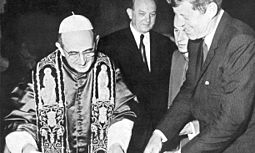
He asked the council members to explain how the Church saw itself in simple words. He thanked representatives from other Christian groups for coming. He also asked for forgiveness if the Catholic Church was to blame for past divisions.
Paul VI concluded the third session of the council on 21 November 1964. He formally declared Mary as the "Mother of the Church".
Between the third and fourth sessions, the Pope announced changes to the Roman Curia (the Vatican's administration) and rules for marriages between different faiths. The council ended on 8 December 1965. At the end, Paul VI announced that he would start the process to make his predecessors, Pope Pius XII and Pope John XXIII, saints.
Call to Holiness
Paul VI believed that a key goal of the Council was the "universal call to holiness". This means that all Christians, no matter their role, are called to live a holy life. This holiness helps create a more human way of living in society.
Church Reforms
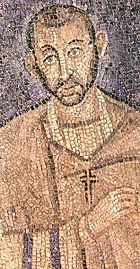
Synod of Bishops
In 1965, he created the Synod of Bishops. This is a permanent group that advises the Pope. They held many meetings on specific topics during his time as Pope.
Vatican Administration Changes
Paul VI knew the Roman Curia very well. He had worked there for many years. He made changes to it in stages. He reduced bureaucracy and brought in more non-Italians to work in Vatican offices.
Age Limits
In 1966, Paul VI asked all bishops to offer their resignations when they turned 75. In 1970, he extended this rule to cardinals. Cardinals would also give up their offices in the Roman Curia at age 80. These rules allowed the Pope to appoint younger leaders. They also reduced the number of Italians in top Vatican jobs. His 1970 rules also meant that cardinals over 80 could not vote in papal elections. This changed how future Popes would be chosen.
Changes to Worship
Paul VI made changes to the Church's worship. He allowed more use of local languages instead of only Latin during baptisms, funerals, and other events. The Second Vatican Council asked for a general update of the Roman Missal (the book used for Mass). Within four years, Paul VI released a new edition in 1969. It included new prayers for the Eucharist.
These changes were not liked by everyone. Some people preferred the older Mass. Later, Pope John Paul II and Pope Benedict XVI allowed the use of the older Mass under certain conditions. However, in 2021, Pope Francis limited its use again.
Relationships and Discussions
Paul VI believed that talking with all people was important to find the truth. He said that everyone should be equal in these discussions.
Dialogues with Other Faiths
In 1964, Paul VI created a special office for talking with non-Christians. A year later, he created another office for talking with non-believers. In 1971, he created an office for economic development and disaster help. To promote peace, he started an annual peace day on January 1st.
He also talked with Communist leaders to improve the situation of Christians in Eastern Europe. He met with Soviet officials in the Vatican. The Church's situation in Hungary, Poland, and Romania improved during his time.
Paul VI sent a message to NASA for the first moon landing by Apollo 11. His message included words from the Bible and a prayer for this amazing start.
Traveling the World
Pope Paul VI was the first Pope to visit six continents. He was also the first Pope to travel by airplane and to visit the Holy Land. He traveled more than any Pope before him, earning the nickname "the Pilgrim Pope". He visited the Holy Land in 1964 and attended big Church meetings in India and Colombia.
In 1966, he was not allowed to visit Poland. In 1967, he visited the shrine of Our Lady of Fátima in Portugal. In 1969, he made the first papal visit to Africa, going to Uganda. On 27 November 1970, someone tried to attack him at the airport in the Philippines. Paul VI was the first Pope to visit the Western Hemisphere when he spoke at the United Nations in New York City in October 1965.
Attempted Attack
Soon after arriving at the airport in Manila, Philippines, on 27 November 1970, a man tried to attack the Pope with a knife. The Pope's personal aide pushed the man away. The Pope continued his trip and thanked those who protected him.
New Diplomacy
Paul VI, like Pope Pius XII before him, focused on having good relationships with all countries. The number of foreign embassies in the Vatican doubled during his time. This showed a new understanding between the Church and governments. The Church stated that it was not tied to any specific government and wanted to work with all of them.
Key Teachings (Encyclicals)
Paul VI wrote seven important letters called encyclicals.
Ecclesiam suam
This letter, from August 1964, talked about the Catholic Church as the Body of Christ. Paul VI asked "all people of good will" to have discussions within the Church and with other churches and even with atheists.
Populorum progressio
Populorum progressio, released in March 1967, was about "the development of peoples". It said that the world's economy should help all people, not just a few. It discussed fair wages, job security, good working conditions, and the right to join a union.
Paul VI also said that true peace depends on justice. He called for a large organization to help with world development, seeing it as a matter of fairness and peace.
Humanae vitae
Of all his letters, Pope Paul VI is most known for Humanae vitae (Of Human Life), published in July 1968. In this letter, he restated the Catholic Church's traditional teachings on marriage and family planning.
He taught that married relations are a union of two people with God, where a new person is created. For this reason, he said that creating human life is a very serious role where married people work with God. He believed that human decisions should not limit God's plan. He knew this letter would cause debate, but he believed it was important.
Spreading the Faith (Evangelism)
By choosing the name Paul, the Pope showed he wanted to follow Paul the Apostle as a model. In 1967, he renamed the Vatican office for spreading the faith to the "Congregation for the Evangelization of Peoples". Paul VI was the first Pope to travel to other continents to spread the Christian message. He chose "evangelism" as the theme for a meeting of bishops in 1974. From that meeting, he wrote an important document in 1975 called Evangelii nuntiandi, about spreading the Gospel.
Working with Other Churches (Ecumenism)
After the council, Paul VI helped continue discussions with other Christian groups. He called them "separated brothers and sisters". He welcomed their visits to Rome. He believed that Catholics needed to do more to be open partners in these discussions. He felt that true dialogue required a Catholic's whole mind, will, and heart.
Orthodox Churches
Paul VI visited the Orthodox leaders in Jerusalem and Constantinople in 1964 and 1967. He was the first Pope in centuries to visit the East and meet with leaders of Eastern Orthodox faiths. His meeting with Ecumenical Patriarch Athenagoras I in 1964 led to taking back the excommunications from the Great Schism of 1054.
This was a big step toward bringing Rome and Constantinople closer. It led to the Catholic-Orthodox Joint declaration of 1965, which showed a desire for more unity. In 1973, the Coptic Patriarch Shenouda III of Alexandria visited the Vatican. They issued a joint statement about shared beliefs.
Anglican Churches
Paul VI was the first Pope to officially receive an Anglican Archbishop of Canterbury, Michael Ramsey, in 1966. Ramsey met Paul three times. They signed a common statement that ended past disagreements and set a plan for the future. Paul VI called the Anglican Church "our beloved sister Church".
Protestant Churches
In 1965, Paul VI started a working group with the World Council of Churches to find ways to talk and work together. They agreed to work together on social justice, development, and issues like hunger and poverty. They also agreed to share in the Week of Prayer for Christian Unity every year.
Paul VI supported working with Protestants. He formally approved a joint Catholic-Protestant translation of the Bible in 1967.
Beatifications and Canonisations
Paul VI declared 38 people "Blessed" and 84 people "Saints" during his time as Pope. Among them were Maximilian Kolbe (Blessed in 1971) and the Ugandan Martyrs (Saints in 1964).
He also named the first two female Doctors of the Church: Teresa of Ávila and Catherine of Siena in 1970.
Appointing Cardinals


Pope Paul VI appointed 143 new cardinals in six ceremonies between 1965 and 1977.
The next three Popes were all made cardinals by Paul VI:
- Albino Luciani (later John Paul I) in 1973.
- Karol Józef Wojtyła (later John Paul II) in 1967.
- Joseph Ratzinger (later Benedict XVI) in 1977.
Paul VI continued the trend of appointing cardinals from all over the world, not just Italy. This meant more cardinals from Africa and Latin America. He also set an age limit of 80 for cardinals to vote in papal elections.
Final Years and Death
Health Challenges
Paul VI was generally healthy before becoming Pope. However, after his election, he needed a serious operation in 1967. He recovered well from this.
Aldo Moro's Kidnapping
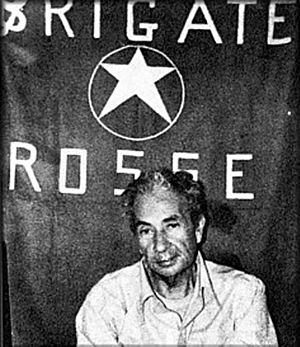
In March 1978, Aldo Moro, a former Italian prime minister and friend of Paul VI, was kidnapped by a terrorist group. The kidnapping lasted 55 days. Moro directly asked the Pope to help.
Paul VI tried to find ways to pay a ransom for Moro, but his efforts were unsuccessful. On 9 May, Aldo Moro's body was found. Pope Paul VI later led his funeral Mass.
His Last Days
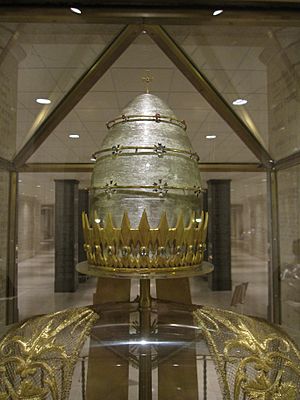
Pope Paul VI went to his summer home, Castel Gandolfo, on 14 July 1978. He was sick but still met with the new Italian President. He had trouble breathing and needed oxygen. On Sunday, 6 August, he was tired and could not say the Angelus prayer.
Death
On 6 August 1978, at 9:41 PM, Paul VI died in Castel Gandolfo. He had a major heart attack. He was conscious for a few hours after the first heart attack, but then felt dizzy and asked those with him to continue praying. His personal secretary and two nuns were with him.
Paul VI left a will asking for a simple burial. He is buried in a grave under the floor of Saint Peter's Basilica, near other Popes.
Becoming a Saint
| Pope Saint Paul VI Patriarch of Rome |
|
|---|---|
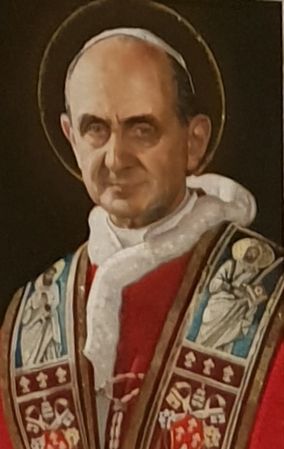 |
|
| Pope; Confessor | |
| Born | Giovanni Battista Enrico Antonio Maria Montini 26 September 1897 Concesio, Brescia, Kingdom of Italy |
| Died | 6 August 1978 (aged 80) Castel Gandolfo, Italian Republic |
| Venerated in | Catholic Church |
| Beatified | 19 October 2014, St. Peter's Square, Vatican City by Pope Francis |
| Canonized | 14 October 2018, St. Peter's Square, Vatican City by Pope Francis |
| Feast | 29 May |
| Attributes | Papal vestments, Papal tiara, Pallium |
| Patronage | Archdiocese of Milan, Paul VI Pontifical Institute, Second Vatican Council, Diocese of Brescia, Concesio, Magenta, Paderno Dugnano |
The process to make Paul VI a saint began in 1993 under Pope John Paul II. This process involves several steps. First, he was called a "Servant of God".
On 20 December 2012, Pope Benedict XVI declared that Paul VI had lived a life of great goodness, giving him the title "Venerable".
For someone to become "Blessed" (beatified), a miracle must be recognized. In 2013, Vatican officials approved a miracle attributed to Paul VI: the healing of an unborn child in California in the 1990s. Pope Francis then beatified Paul VI on 19 October 2014.
For someone to become a "Saint" (canonized), another miracle is usually needed. A second miracle was reported in 2014, involving the healing of an unborn girl in Italy. Doctors and theologians approved this miracle.
On 6 March 2018, Pope Francis confirmed this healing as a miracle. This meant Paul VI could be made a saint. On 14 October 2018, Pope Francis officially made Paul VI a saint. His special day is celebrated on 29 May, the day he became a priest.
See also
 In Spanish: Pablo VI para niños
In Spanish: Pablo VI para niños
- Paul VI Audience Hall
- Paul VI: The Pope in the Tempest
Associated topics
- Credo of the People of God
- Liberation theology
- List of meetings between the pope and the president of the United States
- List of popes


